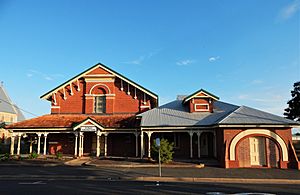St Paul's Anglican Cathedral Hall, Rockhampton facts for kids
Quick facts for kids St Paul's Anglican Cathedral Hall, Rockhampton |
|
|---|---|

St Paul's Anglican Cathedral Hall, 2020
|
|
| Location | 89 William Street, Rockhampton, Rockhampton Region, Queensland, Australia |
| Design period | 1900 - 1914 (early 20th century) |
| Built | c. 1900 |
| Architect | Louis Spier Robertson |
| Architectural style(s) | Arts & Crafts |
| Official name: St Pauls Cathedral Hall & Offices, St Paul's Anglican Cathedral Offices, St Paul's Anglican Cathedral Parish Hall, St Paul's Day School (1902-1912) | |
| Type | state heritage (landscape, built) |
| Designated | 23 June 2000 |
| Reference no. | 601491 |
| Significant period | 1900s (historical) ongoing (social) 1900s (fabric) |
| Significant components | views to, roof/ridge ventilator/s / fleche/s, hall |
| Lua error in Module:Location_map at line 420: attempt to index field 'wikibase' (a nil value). | |
St Paul's Anglican Cathedral Hall is a special building in Rockhampton, Queensland, Australia. It is listed as a heritage site. This means it is an important historical building.
The hall is located on William Street, right next to St Paul's Anglican Cathedral. A famous architect named Louis Spier Robertson designed it. It was built around the year 1900.
Over the years, this building has had a few different names. It was known as St Paul's Anglican Cathedral Offices, St Paul's Anglican Cathedral Parish Hall, and even St Paul's Day School from 1902 to 1912. It was officially added to the Queensland Heritage Register on June 23, 2000.
Contents
History of the Hall
Early Anglican Church in Rockhampton
The first Anglican church leader to visit Rockhampton was Bishop Edward Tufnell in 1860. Before that, local church members held Anglican services in the late 1850s. Soon after Bishop Tufnell's visit, Reverend Thomas Jones arrived. He became a very popular Anglican rector.
Reverend Jones encouraged his church members to raise money. In 1862, they had enough funds to build a small timber church. This first church was built on the same spot where the current Cathedral Hall stands today.
Building the Cathedral
Later, more money was collected for a new, bigger church. Plans were drawn up, and construction of St Paul's Church began in 1872. However, it took a while to finish. The building was not completed and officially blessed until 1883.
In 1892, the Anglican Diocese of Rockhampton was created. A "diocese" is an area managed by a bishop. Because of this, St Paul's Church became the main church, known as the Cathedral Church of Saint Paul the Apostle. The first bishop, Nathaniel Dawes, officially started his role on November 30, 1892.
The Hall's Design and Use
The St Paul's Cathedral Hall is a beautiful building made of red brick. It has wide verandas with wooden posts. It was finished around 1900. This new brick building was first used by the Anglican Church to start the Saint Paul's Day School. The school opened in 1901 and stayed in this building until the end of 1912. After the school moved, the building became known as the Parish Hall.
The hall was designed in 1899 by Louis Spier Robertson. He was an architect and surveyor from Sydney. Robertson moved to Rockhampton in 1896 and started a successful architecture business. He worked in Rockhampton from 1897 until 1905, when he moved back to Sydney. Even after moving, he continued to work on projects in Queensland.
What the Hall Looks Like
St Paul's Anglican Cathedral Hall and Offices is a single-story building. It is made of red brick. It has a main hall and a section of offices on the west side. The building is located at the corner of William and Denison Streets in Rockhampton. It faces William Street. St Paul's Cathedral is nearby, across Alma Lane.
The hall has a simple roof shape called a "gabled roof." Timber brackets support the roof's front overhang. Above the main entrance, there is a part that sticks out with a window. Along the street side, there is a veranda with turned wooden posts. The main entrance has a small porch with a gabled roof.
This building shows an interesting mix of styles. It uses some classic design elements, like the arch over the central gable. However, its details and overall shape are also influenced by the Arts and Crafts movement and Queen Anne style.
The roof is very noticeable, with prominent gables held by brackets. The brickwork is carefully done, and there are special details like a roof vent and terracotta decorations. A plaque with a date is also visible. The large semicircular arch and the roof shape help tell the hall apart from the office section.
Why the Hall is Important
St Paul's Anglican Cathedral Hall was listed on the Queensland Heritage Register in 2000 for several reasons:
- Shows Queensland's History: The hall helps us understand how the Anglican Church grew in regional Queensland, especially in Rockhampton.
- Shows Design Styles: It is a good example of buildings influenced by the Arts and Crafts movement and Queen Anne style, with some unique classical elements.
- Looks Beautiful: The building has special features that make it look appealing. It also fits in well with the other historic buildings on William Street and the Anglican Church area.
- Important to the Community: This place is very important to the Anglican Church community in Rockhampton for social, cultural, and spiritual reasons.
- Connected to Important Work: It has a special link to the history and work of the Anglican Church in regional Queensland. This is especially true since the Diocese of Rockhampton was created in 1892, making this area the main center for the Bishop of Rockhampton.

